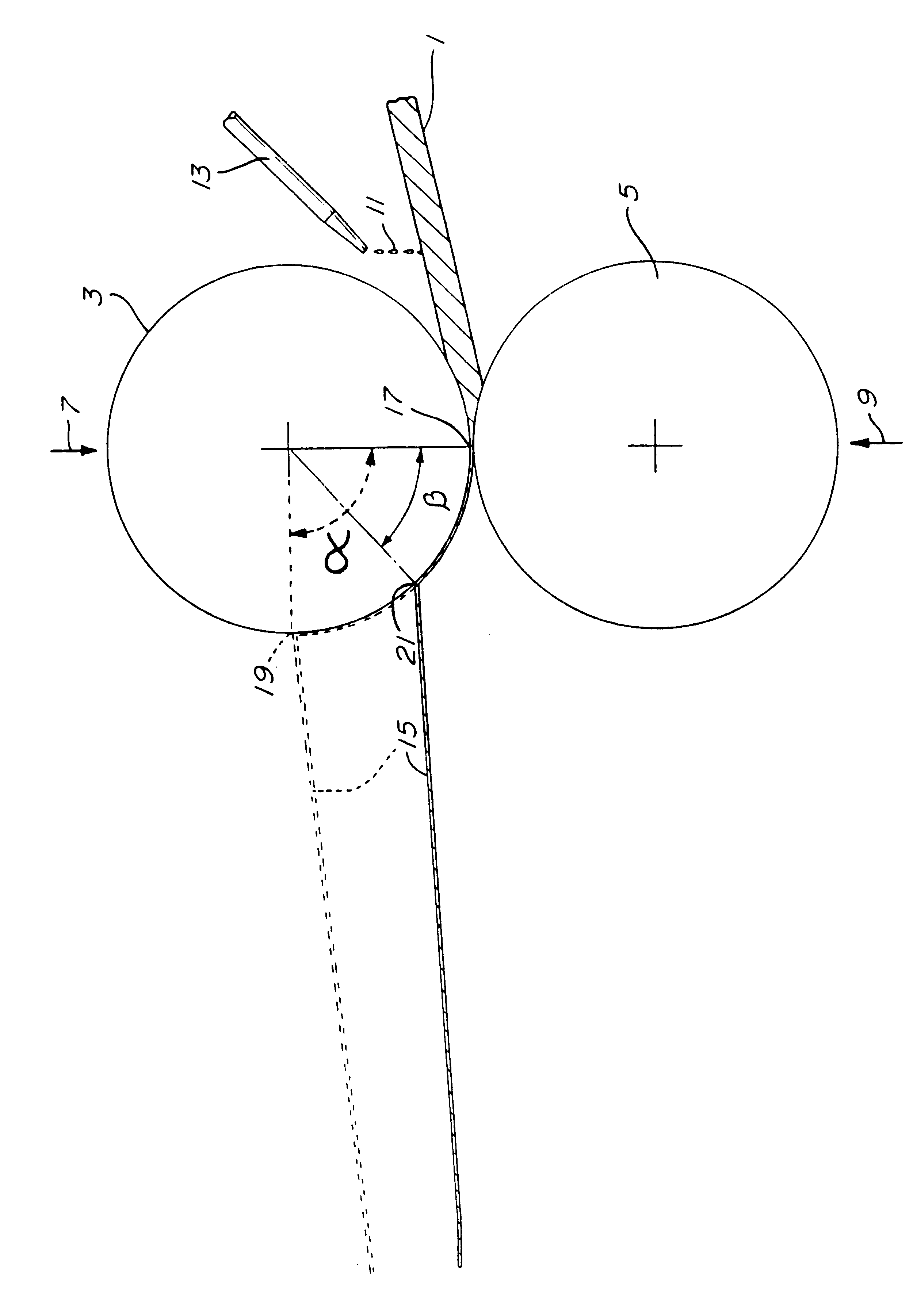Additives for lubricating agents used in the lamination of lithium sheets into thin films
a technology of additives and lithium sheets, applied in the field of additives, can solve the problems of reducing the water content of lithium sheets, affecting the operation of electrochemical cells, and obtaining from suppliers of specialty metals and chemical products, and achieve the effect of reducing the water conten
- Summary
- Abstract
- Description
- Claims
- Application Information
AI Technical Summary
Benefits of technology
Problems solved by technology
Method used
Image
Examples
example 1
In this example, the determining effect of a preferred additive according to the invention on a lamination carried out during a continuous operation and in a single pass to give a lithium film less than 30 micrometers (.mu.), is established. The device used is the one described in FIG. 1 and the lamination is carried out in an anhydride atmosphere containing less than 1% relative humidity. The rollers are made of polyacetal and have a diameter of 20 mm; the starting lithium consists of an extruded sheet 250 micrometers (.mu.) thick. The solvents and the additive, if needed, are previously dehydrated on a molecular sieve in order to give a water concentration lower than 10 ppm.
As a first step, an attempt is made for laminating in a continuous operation a sheet of lithium 57 mm wide and to reduce its thickness in a single pass to 25.mu.. When no lubricating liquid is used during the lamination, lithium immediately adheres to the rollers and the process does not operate properly; with ...
example 2
Lithium 22.mu. produced by utilizing the additive of example 1 is used as the anode of a lithium cell operating at 60.degree. C. The visual aspect of lithium is excellent, the lithium is bright without any coloring, and the surface profile obtained with Dektak.RTM. (model 3030 of VEECO U.S.A.) fluctuates within 3.mu.. For this laboratory test, the lithium sheet is lightly applied under pressure on a thin nickel sheet to ensure current collection. The electrolyte used consists of a polymer electrolyte consisting of a copolymer of ethylene oxide and methylglycidyl ether and a lithium salt, (CF.sub.3 SO.sub.2).sub.2 NLi in an oxygen lithium ratio (O / Li) of 30 / 1. The composite cathode consists of vanadium oxide and carbon black dispersed in the polymer electrolyte and has a capacity of 5 C / cm.sup.2. The active surface of the battery thus constituted is 3.9 cm.sup.2. The initial impedance of this battery at 60.degree. C. is 15.OMEGA., i.e. it is equivalent to or lower than the best lithi...
example 3
In this example, we have evaluated at a temperature of 25.degree. C. the impedance of symmetrical batteries Li.degree. / polymer electrolyte / Li.degree. prepared from laminated lithium without additive and also when covered with an excess of various possible lubricating materials.
The quantity of lubricating agent used per surface unit of lithium is 0.03 mg / cm.sup.2. This value corresponds to an excess of lubricating agent as compared to what is necessary for laminating according to example 1, however the aimed purpose is to amplify and accelerate the electrochemical effect of various additives. The impedance values are given for batteries whose active surface is 3.9 cm.sup.2. The electrolyte of example 1 is also used to prepare batteries which are assembled by hot pressing under vacuum.
For the various material used, the results are the following:
The values observed confirm the influence of the POE segment on the electrolytic conductivity of the additives and enable to conclude that ste...
PUM
| Property | Measurement | Unit |
|---|---|---|
| thicknesses | aaaaa | aaaaa |
| thick | aaaaa | aaaaa |
| thicknesses | aaaaa | aaaaa |
Abstract
Description
Claims
Application Information
 Login to View More
Login to View More - R&D
- Intellectual Property
- Life Sciences
- Materials
- Tech Scout
- Unparalleled Data Quality
- Higher Quality Content
- 60% Fewer Hallucinations
Browse by: Latest US Patents, China's latest patents, Technical Efficacy Thesaurus, Application Domain, Technology Topic, Popular Technical Reports.
© 2025 PatSnap. All rights reserved.Legal|Privacy policy|Modern Slavery Act Transparency Statement|Sitemap|About US| Contact US: help@patsnap.com


